By Jeffrey A. Rendall; Images Courtesy of Titleist
|
|
FAIRHAVEN, MA � �It doesn�t get any better than this.� It�s not a statement that you�ll hear from a scientist, and it�s not something you�ll likely hear from a golf equipment manufacturer, either.
And though every club/ball maker will happily tout the merits of their products vis-�-vis the �other guys,� they�re also certain to insist that, while their clubs/balls are the best on the current market, there�s always room for improvement in the next generation.
That�s the case for Titleist�s newest offerings in the golf ball category � talking about the premium line-up here, their new Pro V1, Pro V1x, NXT Tour, NXT and DT So/Lo.
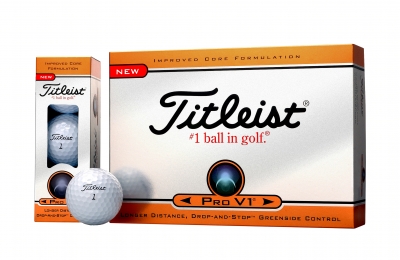 |
| The 2005 Titleist Pro V1 Golf Ball. |
These days, we take a certain amount of skepticism when examining new equipment offerings. From looking at just the past five years, driver heads have gotten bigger and bigger, golf balls have gotten longer and longer, and consumers are inundated with a wide-range of choices when considering that next purchase. Walk into a pro shop and you�ll see the aisles stocked with a host of shiny looking products, all attractively packaged, yet nearly impossible to tell the differences in quality from one row to the next. Brand name�s about all you have to go on.
And according to those in the know at Titleist, the industry is becoming incredibly specialized from top to bottom. And contrary to popular belief, the new stuff coming out is better than what came before, and they�re proving it.
Titleist�s Vice President of Golf Ball Marketing, George Sine, says there are now specialized ways to fit players based on how different golf balls perform � distinguishing amongst the Titleist line, and from other companies� products: �There is certainly room to continue to better fit players to the proper golf ball for them, to optimize launch conditions for golfers employing the new golf ball designs and technology.�
Sine continues, �Said another way, if equipment design optimization is approaching the ten yard line (limited by USGA standards), player fitting and optimization based upon equipment has not even reached mid-field. This is why golf ball selection and our golf club initiatives such as Fitting Works are so important to golfers, golf professionals, instructors and those committed to growing the game. The more enjoyable and rewarding the game and the more positive the experience, the more participation will grow and the more new comers will want to take up the game. Isn't that our obligation, mission and desired outcome, after all?�
Leave it to golf�s #1 ball manufacturer to inject a moral argument into the golf ball wars, but Sine�s got a point. There�s no doubt (or should be none) that the golf balls these days fly farther, straighter and last longer than balls of even a few years ago. From a personal standpoint, it means even mid to high handicappers can play golf courses the way the designers intended them, from an appropriate set of tees.
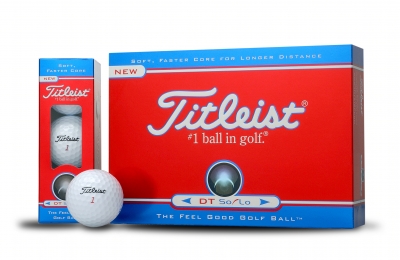 |
| Titleist DT So/Lo Golf Balls |
And who doesn�t think it�s more fun to step back and hit that huge driver a dozen times a round?
Because of equipment advances, the game is more playable, and arguably, more fun. But these same technological improvements mandate a whole new level of specialized fitting that the clubs and balls of old just didn�t require. Long gone are the days you could pick clubs off the rack that wouldn�t differ dramatically from their companions in the next stall. And forget that pile of balls you just stuffed in your pocket from your latest foray into the brush � if they�re not the right ones for your game, you�re only cheating yourself.
Still, it�s a mighty challenge to tell golf balls apart, at least for this reviewer. As simply as we can separate them -- the �cheap� balls don�t seem to fly as far, and they�ve also got a noticeably harder feel than their premium cousins. Sine says that�s where there�ve been large improvements in golf balls � they�re designed to go farther, sure, but they�re also designed to keep you in play and also get closer to the hole from off the green.
�The advancement in ionomer cover materials, as well as the advent of the elastomer/urethane cover material pioneered with the Titleist Pro V1 has enabled golfers of all abilities to experience the durability of hard plastic cover materials with the feel of soft balata cover materials. The importance of the cover material, whether it be cut-proof soft Surlyn or shear and abrasion resistant elastomer/urethane is that the playability and durability experience will be significantly improved versus predecessor cover materials. Additionally, the longevity of play resulting from these cover advancements is a residual benefit to the golfer,� Sine said.
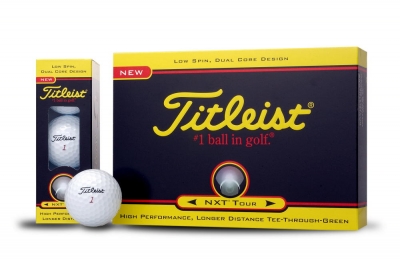 |
| Titleist NXT Tour Golf Balls |
That�s a lotta science. But having played Balata balls for many years and thrown them out after a few swings (because of a huge �smile� that often developed), there�s truth in the statement. Golf balls materials and computer aided design, not to mention better and more accurate robots to test and maximize launch conditions, makes it possible to keep making better golf balls, and better equipment in general.
It also keeps consumers going into those pro shops to try and tap the latest offerings. Myself included.
And it�s not just a matter of choosing the least expensive selections. Sine says you should buy golf balls that will maximize your performance, and seeks to expose a couple of the more popular myths involved in purchasing those little white spheres:
�Myth #1,� Sine says, �is that all golf balls are created equal and they�ll all perform equally well. Truth -- Consistency, quality and overall performance differ significantly between golf ball brands. The established Tour player validated products, such as the Pro V1 and Pro V1x, enjoy significant majorities of not just usage on Tour -- but the overwhelming wins, money and championships on Tour (from Titleist golf balls) are due to their shot-to-shot reliability, and round-to-round consistency and ball-to-ball continuity.�
�Myth #2 deals with the regular player, the consumer: �I am not good enough to tell the difference between golf balls, so shopping for the most golf balls for the lowest possible price is best for my game.� Truth -- Even in the mid-price (NXT, NXT Tour or DT SoLo) range, or value price range (Pinnacle Exception or Pinnacle Gold Distance), there exists noticeable and notable differences in golf ball consistency, cosmetic condition and quality, as well as feel, velocity and durability. If golfers take the time to experience and experiment with different golf ball types based on a cost versus performance equation, as opposed to a pure price decision -- they will be positively rewarded and pleasantly surprised with the results,� Sine lectured.
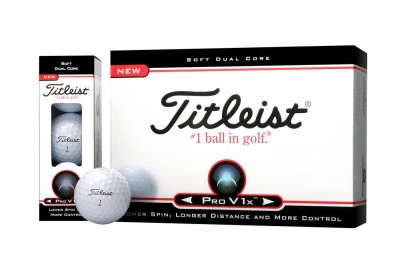 |
| The 2005 Titleist Pro V1x Golf Ball. |
Because of spatial limitations, we�ll summarize the 2005 advancements in Titleist�s golf ball lines as these � different thicknesses of cores, different covers, different materials in all of Titleist�s golf balls are improvements on the �older� models. The �new� versions are basically designed to further reduce spin off the driver for those needing more distance, and also the horizontally challenged � while simultaneously increasing spin around the greens (off the short irons) to help stop the ball near the hole.
This is accomplished through layers of materials in just the right combinations, and cover thicknesses.
You hear it on TV, from the announcers analyzing the professionals � the balls just don�t curve as much. From experience, I�ll still hit �em sideways, but at least they fly straight in that direction. I can honestly say, the new golf ball technology has benefited my game. Because of some inconsistencies in my swing, I�ll never be the straightest hitter, but there�s a certain level of satisfaction derived from the ones that go where they�re supposed to. My previous favorite Titleist ball was the Pro V1, and that�s still true under the current set.
Sine sums up what to look for, the next time you�re in the market for golf balls: �The single most important factor in buying a golf ball -- is that the selection was based upon the golfer's individual needs and that the purchase addressed the opportunity areas of their game. Whether they are distance challenged, accuracy dependent or greenside deficient, the golfer must first and foremost assess and then address this component of their games if the best ball for their respective games is going to be realized.�
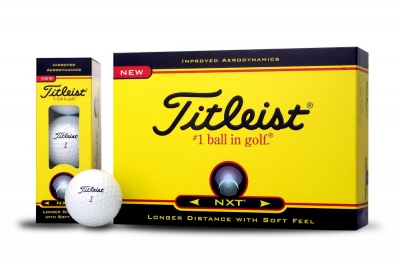 |
| Titleist NXT Golf Balls |
Your trusted golf professional should be able to point you in the right direction towards what needs will best be served by which golf balls. Will the different golf balls save you strokes? Hard to say. But they�ll certainly help you get the most out of what you have, and that�s really all anyone can ask for.
And it doesn�t get any better than that.
Details:
The 2005 line-up of Titleist�s golf balls: Pro V1, Pro V1x, NXT Tour, NXT, and DT So/Lo.
Available at your higher-end golf retailers and club pro shops.
| Related Links | Comments on this article? | |
|
Maryland National Golf Club Hollow Creek Golf Club Rocky Gap Resort PB Dye Golf Club in Ijamsville Whiskey Creek Golf Club |
E-mail Jeff Rendall, Editor: jrendall@golftheunitedstates.com |












